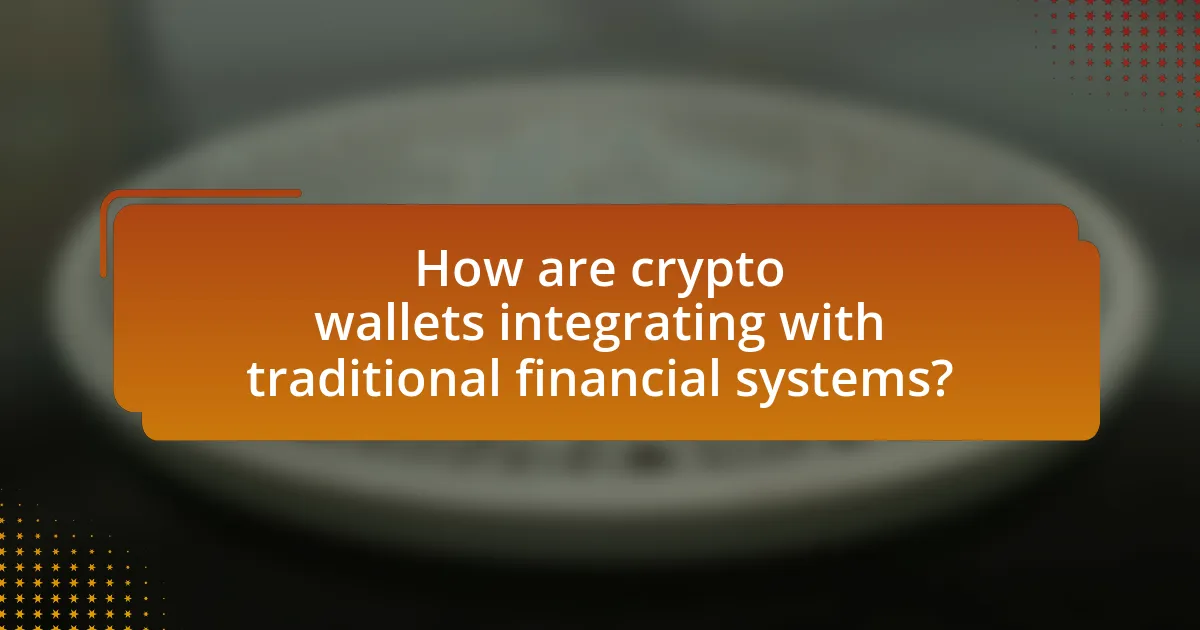Crypto wallets are rapidly evolving to accommodate new payment methods, including contactless payments, stablecoins, and decentralized finance (DeFi) integrations. This evolution enhances user experience by enabling seamless transactions across various platforms and currencies, with features that allow direct linking to bank accounts and credit cards. The article explores the latest trends influencing wallet design, the impact of digital currencies on traditional payment systems, and the importance of user experience and security measures. Additionally, it addresses the challenges wallets face with regulatory compliance and interoperability, while highlighting the role of technological advancements and partnerships with traditional financial institutions in shaping the future of crypto wallets.

How are crypto wallets evolving in response to new payment methods?
Crypto wallets are evolving by integrating support for various new payment methods, such as contactless payments and stablecoins. This evolution allows users to transact seamlessly across different platforms and currencies, enhancing user experience and accessibility. For instance, wallets now often include features that enable users to link their bank accounts or credit cards directly, facilitating instant conversions between fiat and cryptocurrencies. Additionally, the rise of decentralized finance (DeFi) has prompted wallets to incorporate functionalities that allow users to earn interest on their crypto holdings or participate in liquidity pools. These adaptations reflect the growing demand for versatility and convenience in digital transactions, as evidenced by the increasing number of wallet providers that offer multi-currency support and user-friendly interfaces.
What are the latest payment methods influencing crypto wallet design?
The latest payment methods influencing crypto wallet design include contactless payments, decentralized finance (DeFi) integrations, and stablecoins. Contactless payments have gained traction due to their convenience and speed, prompting wallet designs to incorporate NFC technology for seamless transactions. DeFi integrations allow users to access lending, borrowing, and yield farming directly from their wallets, necessitating user-friendly interfaces that simplify complex functionalities. Additionally, the rise of stablecoins, which provide price stability, has led wallets to support multiple stablecoin options, enhancing usability for everyday transactions. These trends reflect the evolving landscape of digital payments and the need for crypto wallets to adapt accordingly.
How do digital currencies impact traditional payment systems?
Digital currencies significantly disrupt traditional payment systems by introducing decentralized transaction methods that reduce reliance on banks and intermediaries. This shift enables faster, borderless transactions with lower fees, as evidenced by Bitcoin’s ability to facilitate international transfers without the need for currency conversion or high transaction costs typically associated with banks. Furthermore, the rise of digital currencies has prompted traditional financial institutions to innovate, leading to the development of digital wallets and payment solutions that integrate cryptocurrency capabilities, thereby enhancing user experience and expanding payment options.
What role do mobile payment solutions play in crypto wallet adaptation?
Mobile payment solutions significantly enhance the adaptation of crypto wallets by providing users with a familiar and convenient interface for transactions. These solutions streamline the process of buying, selling, and using cryptocurrencies, making them more accessible to a broader audience. For instance, the integration of mobile payment platforms like Apple Pay and Google Pay into crypto wallets allows users to transact with cryptocurrencies using their existing payment methods, thereby increasing user engagement and transaction frequency. According to a report by Statista, mobile payment transactions are projected to reach $12 trillion globally by 2025, indicating a growing trend that crypto wallets can leverage to attract more users. This synergy between mobile payments and crypto wallets not only simplifies the user experience but also fosters greater acceptance of cryptocurrencies in everyday transactions.
Why is user experience critical in the evolution of crypto wallets?
User experience is critical in the evolution of crypto wallets because it directly influences user adoption and retention. As the cryptocurrency market grows, wallets must provide intuitive interfaces and seamless functionality to cater to both novice and experienced users. Research indicates that 70% of users abandon apps due to poor usability, highlighting the necessity for crypto wallets to prioritize user-friendly designs. Enhanced user experience fosters trust and encourages more individuals to engage with digital currencies, ultimately driving the broader acceptance of cryptocurrencies as viable payment methods.
How do user preferences shape wallet features and functionalities?
User preferences significantly shape wallet features and functionalities by driving the demand for specific capabilities and user experiences. For instance, if users prioritize security, wallet developers will implement advanced encryption and multi-factor authentication features. Research indicates that 70% of users consider security the most important factor when choosing a wallet, leading to the integration of biometric authentication and cold storage options. Additionally, if users express a preference for ease of use, wallets will incorporate intuitive interfaces and streamlined transaction processes, as evidenced by the rise of mobile wallets that simplify payment methods. Thus, user preferences directly influence the design and functionality of crypto wallets, ensuring they meet the evolving needs of their audience.
What security measures are essential for user trust in crypto wallets?
Essential security measures for user trust in crypto wallets include strong encryption, two-factor authentication (2FA), and regular security audits. Strong encryption protects user data and private keys from unauthorized access, while 2FA adds an additional layer of security by requiring a second form of verification during login. Regular security audits help identify vulnerabilities and ensure compliance with best practices, thereby enhancing user confidence. According to a report by CipherTrace, 2020 saw over $1.8 billion lost to crypto theft, underscoring the necessity of these security measures to maintain user trust.

What challenges do crypto wallets face with evolving payment methods?
Crypto wallets face significant challenges with evolving payment methods, primarily due to the need for interoperability and security. As payment methods diversify, wallets must integrate various cryptocurrencies and traditional currencies, which complicates user experience and requires constant updates to support new technologies. Additionally, the rise of decentralized finance (DeFi) and stablecoins introduces complexities in regulatory compliance and security measures, as wallets must protect against fraud and hacking while ensuring user privacy. According to a report by Chainalysis, the total value of cryptocurrency stolen in hacks reached $3.2 billion in 2021, highlighting the critical need for enhanced security protocols in wallets as payment methods evolve.
How do regulatory changes affect crypto wallet operations?
Regulatory changes significantly impact crypto wallet operations by imposing compliance requirements that wallets must adhere to in order to operate legally. For instance, regulations may mandate Know Your Customer (KYC) and Anti-Money Laundering (AML) procedures, which require wallets to verify user identities and monitor transactions for suspicious activity. This compliance can lead to increased operational costs and may limit the accessibility of wallets for users in certain jurisdictions. According to a report by Chainalysis, regulatory scrutiny has intensified, with over 50 countries implementing stricter regulations on cryptocurrency transactions, affecting how wallets manage user data and transaction processes.
What compliance issues must wallets address in different jurisdictions?
Crypto wallets must address various compliance issues across different jurisdictions, including anti-money laundering (AML) regulations, know your customer (KYC) requirements, data protection laws, and tax compliance. For instance, in the European Union, the Fifth Anti-Money Laundering Directive mandates that wallets implement KYC processes to verify user identities, while the General Data Protection Regulation (GDPR) imposes strict data handling and privacy obligations. In the United States, the Financial Crimes Enforcement Network (FinCEN) requires crypto wallets to register as money services businesses and adhere to AML regulations. These compliance requirements vary significantly by region, necessitating that wallet providers adapt their operations to meet local legal standards.
How do anti-money laundering (AML) regulations impact wallet design?
Anti-money laundering (AML) regulations significantly influence wallet design by necessitating enhanced security features and user verification processes. Wallets must incorporate Know Your Customer (KYC) protocols, requiring users to provide identification and personal information to comply with legal standards. This design shift aims to prevent illicit activities such as money laundering and fraud, aligning with regulatory requirements. Furthermore, wallets are increasingly integrating transaction monitoring systems to detect suspicious activities in real-time, ensuring compliance with AML laws. These adaptations not only enhance security but also foster trust among users and regulatory bodies, reflecting the growing importance of compliance in the cryptocurrency landscape.
What technological advancements are driving changes in crypto wallets?
Technological advancements driving changes in crypto wallets include the integration of multi-signature technology, enhanced security protocols, and the adoption of decentralized finance (DeFi) features. Multi-signature technology allows multiple parties to authorize transactions, increasing security and reducing the risk of theft. Enhanced security protocols, such as biometric authentication and hardware wallet integration, provide users with more secure access to their funds. Additionally, the incorporation of DeFi features enables users to lend, borrow, and earn interest on their crypto assets directly within wallets, reflecting the evolving landscape of digital finance. These advancements are reshaping how users interact with their crypto assets, making wallets more versatile and secure.
How does blockchain technology enhance wallet capabilities?
Blockchain technology enhances wallet capabilities by providing secure, transparent, and decentralized transaction processing. This technology allows wallets to facilitate peer-to-peer transactions without intermediaries, reducing costs and increasing transaction speed. Additionally, blockchain’s immutable ledger ensures that all transactions are recorded permanently and cannot be altered, which enhances security and trust for users. According to a report by the World Economic Forum, blockchain could reduce transaction costs by up to 40% in the financial sector, demonstrating its significant impact on wallet functionality and efficiency.
What innovations in encryption are improving wallet security?
Innovations in encryption that are improving wallet security include advanced cryptographic algorithms, multi-signature technology, and zero-knowledge proofs. Advanced cryptographic algorithms, such as AES-256, provide robust data protection by making unauthorized access extremely difficult. Multi-signature technology enhances security by requiring multiple private keys to authorize a transaction, thereby reducing the risk of theft. Zero-knowledge proofs allow one party to prove possession of certain information without revealing the information itself, which adds an extra layer of privacy and security. These innovations collectively strengthen wallet security against hacking and fraud, as evidenced by the increasing adoption of these technologies in leading cryptocurrency wallets.

How are crypto wallets integrating with traditional financial systems?
Crypto wallets are integrating with traditional financial systems through partnerships with banks and payment processors, enabling seamless transactions between cryptocurrencies and fiat currencies. For instance, companies like Coinbase and BitPay have established collaborations with major banks to facilitate direct deposits and withdrawals, allowing users to convert their digital assets into traditional currency easily. Additionally, the implementation of payment gateways that accept cryptocurrencies in retail environments further bridges the gap, as seen with Visa and Mastercard incorporating crypto transactions into their networks. This integration is supported by regulatory advancements, such as the Financial Action Task Force guidelines, which encourage compliance and security in crypto transactions, thereby fostering trust and adoption among traditional financial institutions.
What partnerships are emerging between crypto wallets and banks?
Emerging partnerships between crypto wallets and banks include collaborations aimed at integrating cryptocurrency services into traditional banking systems. For instance, several banks are partnering with crypto wallet providers to offer customers the ability to buy, sell, and hold cryptocurrencies directly through their banking apps. A notable example is the partnership between Coinbase and various banks, which allows users to link their bank accounts for seamless transactions. Additionally, banks like JPMorgan have begun exploring blockchain technology and digital asset services, indicating a shift towards accommodating crypto wallets within their financial ecosystems. These partnerships are driven by the increasing demand for cryptocurrency services among consumers and the need for banks to innovate in response to evolving payment methods.
How do these partnerships facilitate smoother transactions?
Partnerships between crypto wallets and payment processors facilitate smoother transactions by integrating advanced technologies that streamline payment processes. These collaborations enable real-time transaction processing, reducing delays associated with traditional banking systems. For instance, partnerships with blockchain networks allow for instant verification and settlement of transactions, enhancing user experience. Additionally, these alliances often provide access to a broader range of payment options, accommodating various currencies and methods, which further simplifies the transaction process for users.
What benefits do users gain from integrated financial services?
Users gain several benefits from integrated financial services, including enhanced convenience, streamlined transactions, and improved financial management. Integrated financial services allow users to access multiple financial products, such as banking, investing, and payment processing, within a single platform. This consolidation reduces the need for multiple accounts and simplifies the user experience. Additionally, integrated services often provide real-time data and analytics, enabling users to make informed financial decisions. According to a report by McKinsey & Company, integrated financial services can lead to a 20-30% increase in customer satisfaction due to the seamless experience they offer.
What future trends can we expect in crypto wallet development?
Future trends in crypto wallet development include enhanced security features, integration with decentralized finance (DeFi), and improved user interfaces. Enhanced security will likely involve multi-signature authentication and biometric verification to protect users’ assets, as evidenced by the increasing number of hacks in the crypto space, which reached over $3 billion in 2022. Integration with DeFi platforms will allow wallets to facilitate lending, borrowing, and yield farming directly, reflecting the growing popularity of these services, which saw a total value locked in DeFi exceed $100 billion in early 2023. Improved user interfaces will focus on simplifying the user experience, making crypto transactions more accessible to non-technical users, as indicated by the rise of user-friendly wallets that have gained significant market share.
How will artificial intelligence influence wallet functionalities?
Artificial intelligence will enhance wallet functionalities by enabling advanced security measures, personalized user experiences, and improved transaction efficiency. AI algorithms can analyze user behavior to detect fraudulent activities in real-time, significantly reducing the risk of unauthorized access. For instance, machine learning models can identify patterns in transaction data, allowing wallets to flag suspicious activities instantly. Additionally, AI can facilitate personalized recommendations for users, optimizing their transaction processes based on past behaviors and preferences. According to a report by McKinsey, companies that leverage AI for customer personalization can see a revenue increase of 10-15%. This integration of AI into wallet functionalities not only improves security but also enhances user engagement and satisfaction.
What role will decentralized finance (DeFi) play in wallet evolution?
Decentralized finance (DeFi) will significantly enhance wallet evolution by integrating advanced financial services directly into wallets, enabling users to access lending, borrowing, and trading functionalities without intermediaries. This integration allows wallets to serve as comprehensive financial hubs, facilitating seamless transactions and interactions with decentralized applications (dApps). For instance, as of 2023, platforms like MetaMask and Trust Wallet have incorporated DeFi features, allowing users to earn interest on their crypto holdings or participate in liquidity pools directly from their wallets. This shift not only increases user engagement but also promotes greater financial autonomy and security, as users retain control over their assets without relying on traditional financial institutions.
What best practices should users follow when choosing a crypto wallet?
Users should prioritize security, usability, and compatibility when choosing a crypto wallet. Security features such as two-factor authentication, encryption, and backup options are essential to protect assets from theft or loss. Usability refers to the wallet’s interface and ease of navigation, which can significantly impact the user experience, especially for beginners. Compatibility with various cryptocurrencies and integration with exchanges or payment platforms ensures that users can manage their assets effectively. According to a 2021 survey by Statista, 39% of cryptocurrency users consider security the most important factor when selecting a wallet, highlighting the critical nature of these best practices.
How can users assess the security features of a crypto wallet?
Users can assess the security features of a crypto wallet by examining its encryption methods, two-factor authentication (2FA), and backup options. A wallet that employs strong encryption protocols, such as AES-256, ensures that user data is securely stored and transmitted. Additionally, wallets that offer 2FA add an extra layer of security by requiring a second form of verification, which significantly reduces the risk of unauthorized access. Furthermore, reliable wallets provide backup options, allowing users to recover their funds in case of device loss or failure. According to a report by the Blockchain Security Alliance, wallets with these features are less likely to be compromised, highlighting the importance of these security measures in protecting digital assets.
What factors should users consider regarding wallet usability and support?
Users should consider the wallet’s user interface, compatibility with various cryptocurrencies, security features, and customer support options when evaluating usability and support. A user-friendly interface enhances navigation and transaction processes, while compatibility ensures that the wallet can handle multiple cryptocurrencies, which is essential given the diverse crypto landscape. Security features, such as two-factor authentication and encryption, protect users’ assets from potential threats. Additionally, responsive customer support is crucial for resolving issues quickly, as evidenced by a survey indicating that 70% of users prioritize support availability when choosing a wallet.


